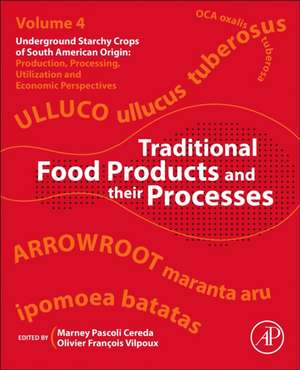Traditional Starch Food Products: Application and Processing
Editat de Marney Pascoli Cereda, Olivier Francois Vilpouxen Limba Engleză Paperback – 24 sep 2024
This book describes the use of starchy roots, tubers and rhizomes in food, medicine, local culture, and religion, emphasizing the vital roles they play in indigenous Andean or Amazonian communities, offering cultural identity and economic value.
The book’s comprehensive exploration highlights the multifaceted world of underground starchy crops, emphasizing the challenges to their successful development and preservation.
Edited by a team of experts with solid background on starch extraction research, these books are aimed at all those involved in research and development, new technology processes and quality control and legislation in the field of starch.
- Thoroughly explores traditional, post-harvest processes and innovation in conservation of fresh roots and tubers
- Examines nutrients and antinutrients in starchy roots, tubers and rhizomes
- Includes traditional as well as innovative food processing technologies through cooking and freezing
Preț: 903.72 lei
Preț vechi: 1182.24 lei
-24% Nou
Puncte Express: 1356
Preț estimativ în valută:
172.93€ • 188.43$ • 145.72£
172.93€ • 188.43$ • 145.72£
Carte tipărită la comandă
Livrare economică 16-30 aprilie
Preluare comenzi: 021 569.72.76
Specificații
ISBN-13: 9780323908443
ISBN-10: 0323908446
Pagini: 430
Dimensiuni: 191 x 235 mm
Greutate: 0.74 kg
Editura: ELSEVIER SCIENCE
ISBN-10: 0323908446
Pagini: 430
Dimensiuni: 191 x 235 mm
Greutate: 0.74 kg
Editura: ELSEVIER SCIENCE
Cuprins
1. Introduction—underground starchy crops in food use
Part 1: General Themes
2. Cooking of cassava roots: problems and solutions
3. Food application of starch in complex media
4. Roots and tubers processing for cooking purposes: ready-to-eat, vacuum and frozen products, French fries, and chips
Part 2: Traditional foods in lowland regions
5. Roots and tubers in Colombia’s culinary and food traditions
6. Traditional Amerindian cassava-based foods and drinks in the Amazon region
7. Traditional cassava foods in the Brazilian state of Para´: tucupi, tacaca´, manic¸oba, and others
8. Brazilians’ cassava flours and derivates
9. Etanol, spirits and beer produced from underground starchy raw materials
10. Use of arrowroot (Maranta arundinacea L.) and canna (Canna edulis Ker) for the formulation of products, including baked and confectionery staple goods
11. Traditional uses, processing, and markets: the case of sweetpotato (Ipomoea batatas (L.) Lam.)
Part 3: Traditional foods in andean region
12. Traditional uses, processes, and markets: the case of Mashua (Tropaeolum tuberosum Ruı´z & Pav.)
13. Traditional uses, processes, and markets: the case of mauka (Mirabilis expansa [Ruı´z & Pav.] Standl.)
14. Traditional uses, processes, and markets: the case of maca (Lepidium meyenii Walp.)
15. Traditional uses, processes, and markets: the case of Yacon (Smallanthus sonchifolius [Poepp.] H.Rob.)
16. Traditional uses, processes, and markets: the case of arracacha (Arracacia xanthorrhiza Bancroft)
17. Traditional uses, processes, and markets of native potatoes (Solanum spp.)
18. Ajipa (Pachyrhizus ahipa [Wedd.] Parodi): traditional use, process, marketplace, issues, and outlook
19. Traditional uses, processes, and markets: the case of oca (Oxalis tuberosa Molina)
20. Traditional uses, processes, and markets of ulluco (Ullucus tuberosus Caldas)
21. Traditional uses, processes, and markets: the case of achira (Canna indica L.)
22. Traditional uses, processes, and markets: the case of cassava (Manihot esculenta Crantz)
Part 1: General Themes
2. Cooking of cassava roots: problems and solutions
3. Food application of starch in complex media
4. Roots and tubers processing for cooking purposes: ready-to-eat, vacuum and frozen products, French fries, and chips
Part 2: Traditional foods in lowland regions
5. Roots and tubers in Colombia’s culinary and food traditions
6. Traditional Amerindian cassava-based foods and drinks in the Amazon region
7. Traditional cassava foods in the Brazilian state of Para´: tucupi, tacaca´, manic¸oba, and others
8. Brazilians’ cassava flours and derivates
9. Etanol, spirits and beer produced from underground starchy raw materials
10. Use of arrowroot (Maranta arundinacea L.) and canna (Canna edulis Ker) for the formulation of products, including baked and confectionery staple goods
11. Traditional uses, processing, and markets: the case of sweetpotato (Ipomoea batatas (L.) Lam.)
Part 3: Traditional foods in andean region
12. Traditional uses, processes, and markets: the case of Mashua (Tropaeolum tuberosum Ruı´z & Pav.)
13. Traditional uses, processes, and markets: the case of mauka (Mirabilis expansa [Ruı´z & Pav.] Standl.)
14. Traditional uses, processes, and markets: the case of maca (Lepidium meyenii Walp.)
15. Traditional uses, processes, and markets: the case of Yacon (Smallanthus sonchifolius [Poepp.] H.Rob.)
16. Traditional uses, processes, and markets: the case of arracacha (Arracacia xanthorrhiza Bancroft)
17. Traditional uses, processes, and markets of native potatoes (Solanum spp.)
18. Ajipa (Pachyrhizus ahipa [Wedd.] Parodi): traditional use, process, marketplace, issues, and outlook
19. Traditional uses, processes, and markets: the case of oca (Oxalis tuberosa Molina)
20. Traditional uses, processes, and markets of ulluco (Ullucus tuberosus Caldas)
21. Traditional uses, processes, and markets: the case of achira (Canna indica L.)
22. Traditional uses, processes, and markets: the case of cassava (Manihot esculenta Crantz)
